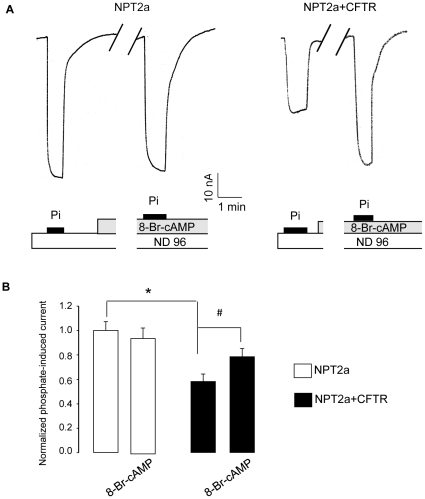XB-IMG-127080
Xenbase Image ID: 127080

|
Figure 4. Effect of a permeant cAMP analog on the phosphate-induced current in NPT2a-oocytes or NPT2a+CFTR-oocytes.Phosphate-induced current (IPi) was measured in voltage-clamped (−50 mV) NPT2a- or co-and NPT2a+CFTR-oocytes. A. Original tracings obtained from a NPT2a-oocyte (left), and from a NPT2a+CFTR-oocyte (right), exposed in a reversible manner to 1 mM Pi, as indicated by a black bar. As indicated below the tracings, IPi was first induced in basal condition, basalIPi (superfusion of ND96 supplemented with 1 mM Pi), then in an experimental condition, exptlIPi, herein after 10 min exposure to 8 Bromoadenosine-3′5′-cyclic monophosphate (8-Br-cAMP, 100 µM). The break in each trace represents a ∼ 9 min exposure to the cAMP agonist that is not shown. B. Summary of the results (means ± SEM) of the effect of 8-Br-cAMP, 100 µM, on IPi in NPT2a-oocytes (n = 8, white columns) and in NPT2a+CFTR-oocytes (n = 8, black columns) from N = 3 experiments. Measured IPi were normalized against basalIPi from NPT2a-oocytes from the same batch of oocytes. The significance of the difference between Pi-induced currents measured in basal or in experimental conditions in NPT2a+CFTR-oocytes and basalIPi from NPT2a-oocytes was analyzed using unpaired Student’s t-test (*: P < 0.05). The significance of the difference between basalIPi and exptlIPi within the same type of oocytes was assessed using paired Student’s t-test (#: P < 0.05). Image published in: Bakouh N et al. (2012) Bakouh et al. Creative Commons Attribution license Larger Image Printer Friendly View |
